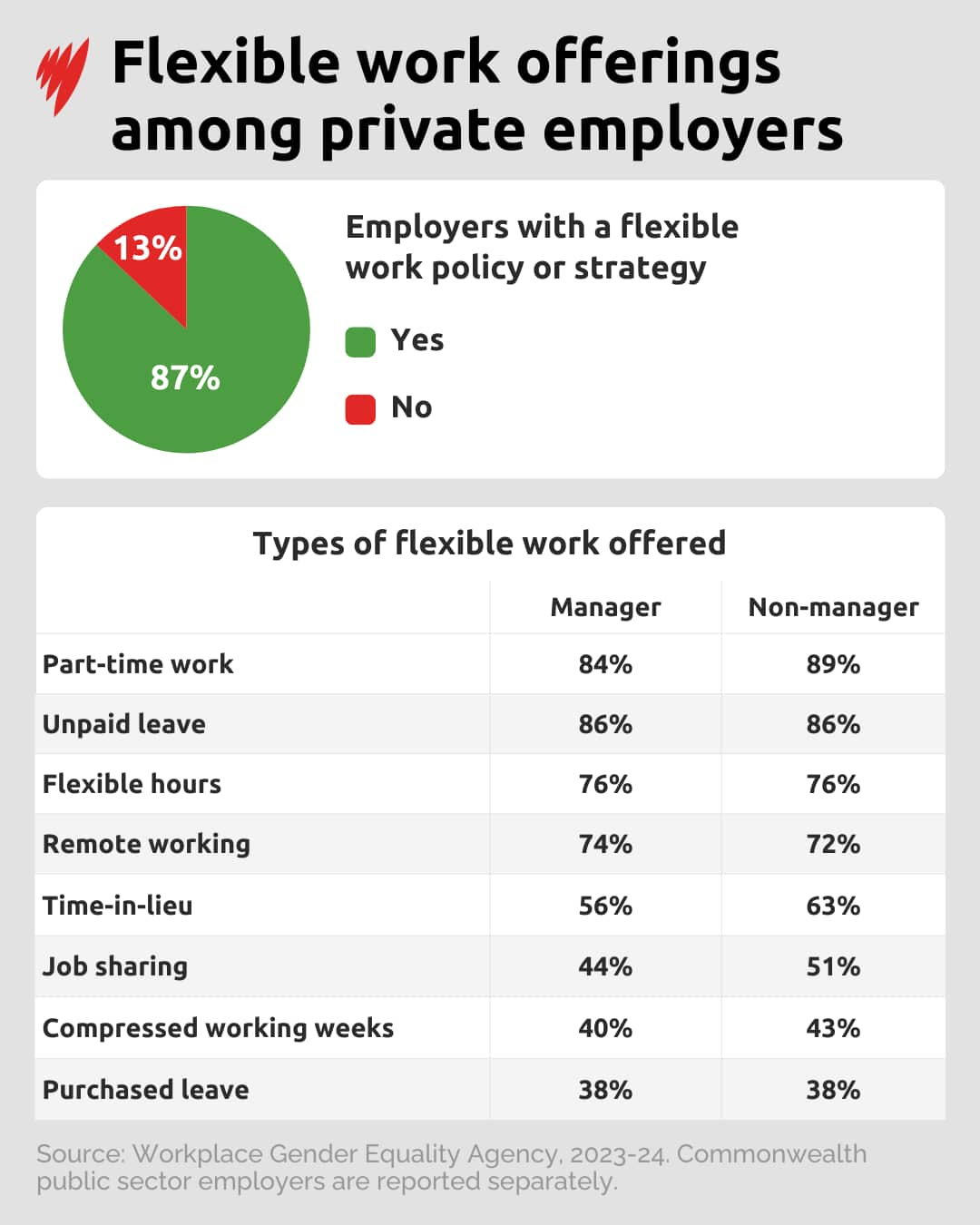As the new working year sets in, some Australians might be thinking about ways to better balance their work and personal lives.
Demand for flexible work arrangements has grown significantly since the COVID-19 pandemic struck and lockdowns forced many to log on from home.
Organisations that were met with some pushback, according to Dr Melissa Wheeler — a senior lecturer in business and management at RMIT University — as some workers were reluctant to return to the “status quo”.
“They felt a bit put off because they had been asked to shift rapidly to a different way of working, they got used to it, they accommodated their life and they showed that they could do it,” she told SBS News.
“That demand is still there.”
John Hopkins, an associate professor of management at Swinburne University, said employers have become “a lot more accommodating” of requests for flexible work in recent years.
Mary Wooldridge, chief executive of the Workplace Gender Equality Agency (WGEA) — which tracks how employers respond to indicators gender equality indicators including flexible work — agreed.
“We are seeing an increase in employers that have policies around flexible working and also an increase in the range of options that are being offered,” she said.
The government statutory agency monitors the actions of workplaces across the country towards addressing gender equality. One of its six priority indicators includes flexible work, which Wooldridge said has a “gendered aspect”.
That includes women often needing to accommodate caring responsibilities, and men previously being more likely to have requests rejected.
But she said the tide is turning.
What is flexible work?
While flexible work might feel synonymous with working from home, the term covers a much broader range of workplace arrangements.
The WGEA defines a flexible work arrangement as one between an employer and an employee to change standard working practices to better accommodate the employee’s commitments out of work.
According to the Fair Work Ombudsman, the country’s workplace regulator, this comes in many forms related to the hours, pattern and location of work.
Examples include:
- Flexible start and finish times
- Compressed hours (working more hours over fewer days)
- Changing from full-time to part-time or casual work
- Job sharing
- Flexible rostering
- Working from home or another location
- ‘Purchasing’ extra paid leave
- Unpaid leave
- Time off in lieu
What are the benefits and challenges of flexible work?
Hopkins said flexible work can help employees get more time back in their day, save money on things like meals and travel, and combine work and non-work-related tasks.
“Anything that benefits the employee tends to benefit the employer as well because people are happier when they have a better arrangement and work-life balance,” he said.
Wheeler said one of the biggest benefits is well-being. She pointed to trials of a four-day workweek, which she says have largely shown positive impacts on employees.
“They report feeling less stressed, needing less sick days, feeling more energised,” she said.
“All of those benefits add up in terms of retaining good employees and also reducing sick days, which can be disruptive.”
Hopkins said studies from around the world had looked into the impacts of flexible work on productivity — and there are differing views.
“It tends to be that flexible work doesn’t impact productivity in a negative way,” he said.
“Certainly, with respect to time spent in the office, once you get past that three days out of five per week, productivity doesn’t go up.”
Wooldridge said recent evidence from the shift towards working from home and other forms of flexible work has shown “productivity is maintained” in flexible work conditions.
However, Wheeler argued that more longitudinal research is needed on the issue more broadly.
A lack of socialising is one of the negative outcomes of flexible work, she said.
Hopkins said managing different arrangements can be complex, and varied schedules within a team may add to challenges around availability.
Flexible working in Australia
Data from the Australian Bureau of Statistics shows 36 per cent of employed people This was down slightly from 37 per cent in August 2023 — the first percentage decrease since the pandemic started in 2020.
About 30 per cent of employees had an agreement to work flexible hours in August last year, and 61 per cent had some say in their start or finish times. About 34 per cent of employees were able to work extra hours in order to take time off.
In August 2024, around 30 per cent of employees had an agreement to work flexible hours. Source: SBS News
When it comes to employers, 87 per cent of the Australian private sector had a formal policy or strategy on flexible working arrangements in 2023-24, according to the WGEA.
Among the options offered were unpaid leave and flexible work hours (86 per cent and 76 per cent for managers and non-managers, respectively) along with job sharing (44 per cent for managers and 51 per cent for non-managers).
The WGEA collects data from around 9,000 employers each year. All private employers with 100 or more employees are required to report their data.
Commonwealth public sector employers with 100 or more employees reported to the WGEA for the first time in 2023.
The agency’s public sector scorecard, released last year, found 97 per cent of these 116 employers had a flexible work policy or strategy in 2022.
Flexible options such as unpaid leave, working from home and job sharing were offered by 100 per cent, 99 per cent and 94 per cent of employers, respectively.
All private employers with 100 or more employees are required to report their data to the WGEA. Source: SBS News
Commonwealth public sector employers with 100 or more employees reported to the WGEA for the first time in 2023. Source: SBS News
Who can request a flexible working arrangement?
According to Fair Work, anyone can request flexibility — but some employees have a legal entitlement to request an arrangement under the Fair Work Act.
This includes permanent employees who have worked with their employer for at least 12 months and casual employees who have had regular work over a 12-month period.
Such employees can request a flexible working arrangement if they are:
- pregnant
- a parent or have responsibility for the care of a child who is school-aged or younger
- a carer under the Carer Recognition Act 2010
- a person with a disability
- aged 55 or older
- experiencing family and domestic violence
- supporting an immediate family member, or someone they live with, who is experiencing family and domestic violence
According to Fair Work, if a state or territory law offers an employee a better entitlement to flexible working arrangements, then that law still applies.
Hopkins said employees who sit outside these groups can still approach their employer with a request, but it would not be covered by the current Fair Work Act.
Rules might also be contained in an employee’s award, agreement, employment contract or workplace policies — but these cannot “exclude or provide for less than the Act”.
How should you bring it up with your boss?
Employees who qualify for these criteria are required to make their request in writing, setting out the details and reasons.
For requests that fall under the Act, employers must respond in writing within 21 days.
When can a request be refused?
According to Fair Work, an employer can refuse a request “if they have reasonable business grounds and have taken certain steps”. Reasonable grounds may include cost, capacity, practicality, inefficiency or customer service impact.
Hopkins said workers should keep these in mind when making a request.
“Reverse-engineer it. Look at why you want the arrangement, how it will be beneficial to you — and look at it from the organisation’s perspective. Is there a cost associated with this? … Would it impact your productivity?”
If a request dispute cannot be resolved at a workplace level, an application can be made to the Fair Work Commission.
David Alexander, the Australian Chamber of Commerce and Industry’s head of policy and advocacy, said flexible working arrangement discussions are best resolved at the workplace level “with a view to the unique circumstances of a particular business — not by dictates from Canberra”.
Wooldridge said arrangements must be monitored, and that teams require the skills to manage a more flexible working environment.
“We certainly encourage employers to be open to the conversations about the needs and wishes of their employees.”




